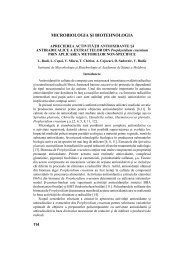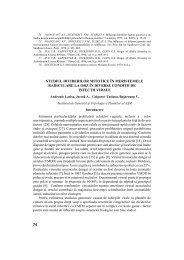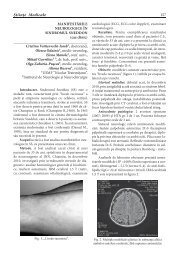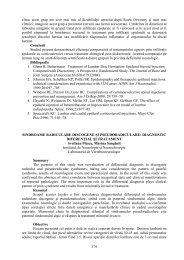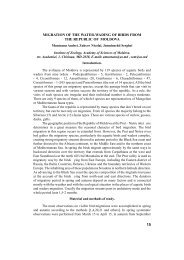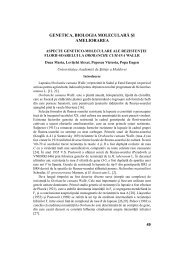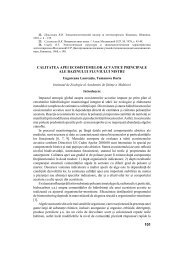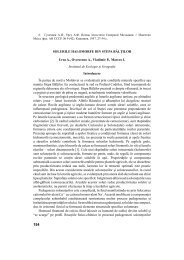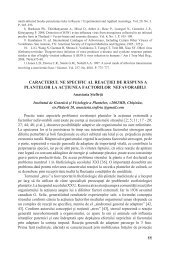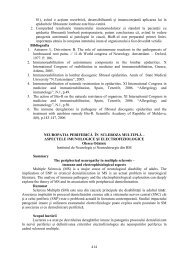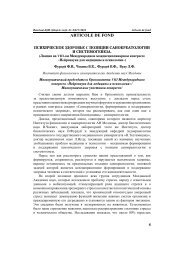209 CUPRINS
209 CUPRINS
209 CUPRINS
Create successful ePaper yourself
Turn your PDF publications into a flip-book with our unique Google optimized e-Paper software.
SUMMER HEAT EPISODES IN THE CZECH REPUBLIC AND<br />
THE REPUBLIC OF MOLDOVA: A COMPARATIVE ANALYSIS<br />
Ala Overcenco 1 , Vera Potop 2<br />
1 National Center for Public Health, Laboratory of Socio-Hygienic Monitoring,<br />
Republic of Moldova<br />
2 Czech University of Life Sciences Prague, Faculty of Agrobiology, Food and<br />
Natural Resources, Department of Agroecology and Biometeorology, Czech Republic<br />
Introduction<br />
Many research activities during the 20th century have focused on extreme climate<br />
phenomena, including heat waves, because of their in uences on ecosystems and human<br />
society (agriculture, water resources, energy demand and human mortality). One reason<br />
for the enhanced interest in the warm temperature extremes stems from a concern that<br />
the frequency and severity of such events, especially across Europe, have increased<br />
recently, and that this trend is likely to continue due to global warming [11,12,18]. The<br />
impact of extreme events is more serious when the extreme weather conditions prevail<br />
over extended periods. Moreover, unusually warm summers, observed increasingly<br />
frequently in various regions of the world in the recent years, indicate that such a<br />
«hot future» is not so far [2]. A classic example is an extremely hot summer of 2003<br />
in Western Europe that caused thousands of excess deaths and enormous economic<br />
damage in many countries, including the developed ones. The 2006 European heat<br />
wave was also a period of exceptionally hot weather that arrived at the end of June,<br />
2006 in certain European countries and was clearly located more northward of Europe<br />
than in the summer of 2003. The regions such as Northern France, Germany, Belgium,<br />
and the Czech Republic, which were strongly exposed to the 2003 heat wave, were<br />
affected by an even more extreme heat wave in the July of 2006, in terms of absolute<br />
mean monthly values. Much less studied is the summer heat of 2007 in South-Eastern<br />
Europe that affected a lot of countries, including Italy, Greece, Hungary, Romania,<br />
Bulgaria, Moldova and others.<br />
In this paper, we present the results of two research goals: (1) a comparative<br />
assessment of the extremely hot summer of 2006 in the Czech Republic (CR) and of<br />
2007 in the Republic of Moldova (RM) as climatic phenomenon and (2) identi cation<br />
of heat episodes (tropical days and heat waves) in these countries during 1961-2009 as<br />
evidence of changing climate.<br />
Material and methods<br />
This paper analyses a 49-yr (1961-2009) time series of daily temperatures<br />
(maximum, minimum, and mean daily temperature) in the Republic of Moldova and the<br />
Czech Republic. The data series of daily air temperature in summer season (June-July-<br />
August) were available for the Czech Republic from the Czech Hydrometeorological<br />
Institute and for Republic of Moldova from the Hydrometeorology data service system<br />
CliWare of the All-Russian Research Institute of Hydrometeorological Information<br />
[22]. There are no missing values in the datasets over the period of June to August.<br />
Available datasets consist of measurements at two selected weather stations in both<br />
167



